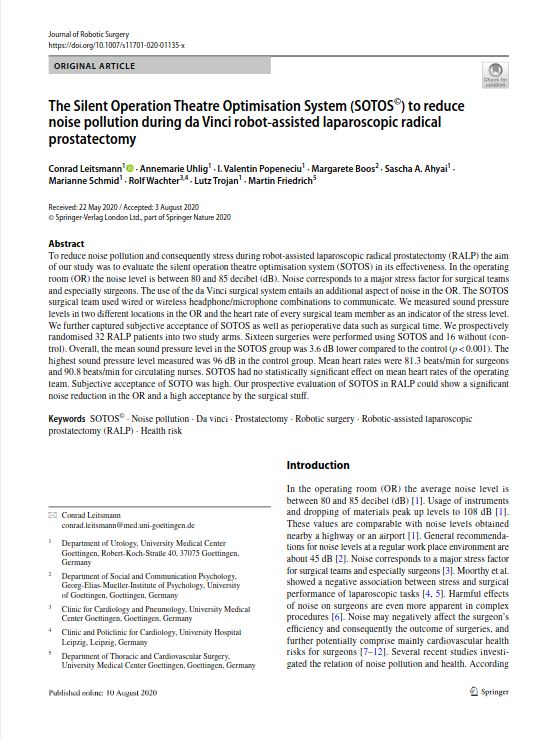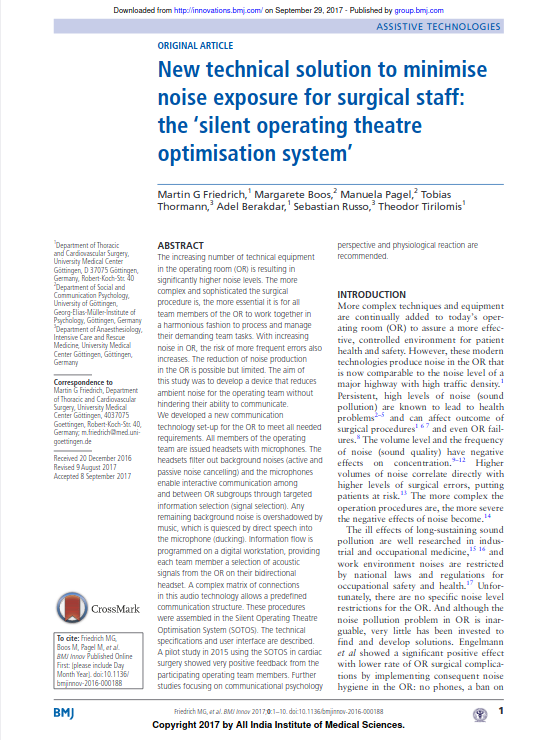 Abstract
Abstract
Background Noise in operating theaters (OT) exceeds safety standards with detrimental effects on the health and performance of OT crews as well as patient safety. One of the reasons for these effects is the stress response to noise, which could be minimized by the Silent Operating Theater Optimisation System (SOTOS), a noise reductive headset solution. Methods This study evaluates the effects of the SOTOS on the stress perceived by OT crew members, operationalized through stress level and exhaustion. Twenty-one heart surgeries and 32 robot-assisted prostatectomies at the University Medical Center Goettingen, Germany were examined. Twenty-six surgeries were conducted with and
27 without the SOTOS. The SOTOS-effect is defined as a more beneficial stress course from before to after surgery, when comparing the experimental group with and control group without SOTOS. Findings Eighty-one OT workers were investigated. The linear multilevel models revealed significant interactions between treatment and time of measurement on stress level (F[1, 406.66] ¼ 3.62, p ¼ 0.029) and exhaustion (F[1, 397.62] ¼ 13.12, p ¼ 0.00017). Nevertheless, there was no a significant main effect of surgery type on stress level (F[1, 82.69] ¼ 1.00, p ¼ 0.32) or on exhaustion (F[1, 80.61] ¼ 0.58, p ¼ 0.45). Additionally, no significant three-way interaction including surgery type, for stress level (F[1, 406.66] ¼ 0.32, p ¼ 0.29) or exhaustion (F[1, 397.62] ¼ 0.03, p ¼ 0.43), was found. Interpretation An SOTOS-effect was confirmed: the development of stress over the course of an operation was beneficially modified by the SOTOS. Both surgery types are perceived as similarly stressful, and the staff benefits equally strongly from the
intervention in both settings
File: Type PDF / Size: 1.2 MB/ Download
 Abstract
Abstract
To reduce noise pollution and consequently stress during robot-assisted laparoscopic radical prostatectomy (RALP) the aim of our study was to evaluate the silent operation theatre optimisation system (SOTOS) in its effectiveness. In the operating room (OR) the noise level is between 80 and 85 decibel (dB). Noise corresponds to a major stress factor for surgical teams and especially surgeons. The use of the da Vinci surgical system entails an additional aspect of noise in the OR. The SOTOS surgical team used wired or wireless headphone/microphone combinations to communicate. We measured sound pressure levels in two different locations in the OR and the heart rate of every surgical team member as an indicator of the stress level. We further captured subjective acceptance of SOTOS as well as perioperative data such as surgical time. We prospectively randomised 32 RALP patients into two study arms. Sixteen surgeries were performed using SOTOS and 16 without (con-trol). Overall, the mean sound pressure level in the SOTOS group was 3.6 dB lower compared to the control (p < 0.001). The highest sound pressure level measured was 96 dB in the control group. Mean heart rates were 81.3 beats/min for surgeons and 90.8 beats/min for circulating nurses. SOTOS had no statistically significant effect on mean heart rates of the operating team. Subjective acceptance of SOTO was high. Our prospective evaluation of SOTOS in RALP could show a significant noise reduction in the OR and a high acceptance by the surgical stuff.AbstractTo reduce noise pollution and consequently stress during robot-assisted laparoscopic radical prostatectomy (RALP) the aim of our study was to evaluate the silent operation theatre optimisation system (SOTOS) in its effectiveness. In the operating room (OR) the noise level is between 80 and 85 decibel (dB). Noise corresponds to a major stress factor for surgical teams and especially surgeons. The use of the da Vinci surgical system entails an additional aspect of noise in the OR. The SOTOS surgical team used wired or wireless headphone/microphone combinations to communicate. We measured sound pressure levels in two different locations in the OR and the heart rate of every surgical team member as an indicator of the stress level. We further captured subjective acceptance of SOTOS as well as perioperative data such as surgical time. We prospectively randomised 32 RALP patients into two study arms. Sixteen surgeries were performed using SOTOS and 16 without (con-trol). Overall, the mean sound pressure level in the SOTOS group was 3.6 dB lower compared to the control (p < 0.001). The highest sound pressure level measured was 96 dB in the control group. Mean heart rates were 81.3 beats/min for surgeons and 90.8 beats/min for circulating nurses. SOTOS had no statistically significant effect on mean heart rates of the operating team. Subjective acceptance of SOTO was high. Our prospective evaluation of SOTOS in RALP could show a significant noise reduction in the OR and a high acceptance by the surgical stuff.
File: Type PDF / Size: 1 MB/ Download
 Abstract
Abstract
BackgroundNoise in the operating room (OR) is a stressor with far-reaching negative consequences. The Silent Operating Theatre Optimisation System (SOTOS) suppresses the noise level in the OR and improves the communication of the OR-staff. This study investigates whether SOTOS has a positive impact on the OR-staff’s perceived stress, exhaustion, activity and concentration.MethodsData were collected in a quasi-experimental study design of 32 radical prostatectomies using the da Vinci robotic-assisted system. Sixteen randomly chosen surgeries were carried out with SOTOS and 16 without. A total of 34 OR-staff-members took part, each 32 surgeries involving five planned OR-staff-members. Two points of measurement, before and after each surgery, were carried out, with a final sample of n=143 repeated measurements data. Before and after surgery, OR-staff-members completed a concentration test and a questionnaire concerning their perceived stress, exhaustion and activity levels.ResultsThe OR-staff felt significantly less stressed, less exhausted and more active during and after surgery when operating with SOTOS. Especially the primary surgeons, assisting surgeons and circulating nurses profited from SOTOS. SOTOS did not reveal a significant impact on the OR-staff’s concentration in this study.ConclusionFor urological surgeries using the da Vinci system SOTOS constitutes a technical resource which significantly reduces perceived noise stress and exhaustion and improves the activity of primary surgeons, assisting surgeons and circulating nurses. These efficiencies likely lead to positive changes in their health and job satisfaction and are hence beneficial to the patient safety and hospital resources.
File: Type PDF / Size: 1 MB/ Download
 Abstract
Abstract
The increasing number of technical equipment in the operating room (OR) is resulting in significantly higher noise levels. The more complex and sophisticated the surgical procedure is, the more essential it is for all team members of the OR to work together in a harmonious fashion to process and manage their demanding team tasks. With increasing noise in OR, the risk of more frequent errors also increases. The reduction of noise production in the OR is possible but limited. The aim of this study was to develop a device that reduces ambient noise for the operating team without hindering their ability to communicate. We developed a new communication technology set-up for the OR to meet all needed requirements. All members of the operating team are issued headsets with microphones. The headsets filter out background noises (active and passive noise cancelling) and the microphones enable interactive communication among and between OR subgroups through targeted information selection (signal selection). Any remaining background noise is overshadowed by music, which is quiesced by direct speech into the microphone (ducking). Information flow is programmed on a digital workstation, providing each team member a selection of acoustic signals from the OR on their bidirectional headset. A complex matrix of connections in this audio technology allows a predefined communication structure. These procedures were assembled in the Silent Operating Theatre Optimisation System (SOTOS). The technical specifications and user interface are described. A pilot study in 2015 using the SOTOS in cardiac surgery showed very positive feedback from the participating operating team members. Further studies focusing on communicational psychology perspective and physiological reaction are recommended.
File: Type PDF / Size: 4 MB/ Download
 Abstract
Abstract


